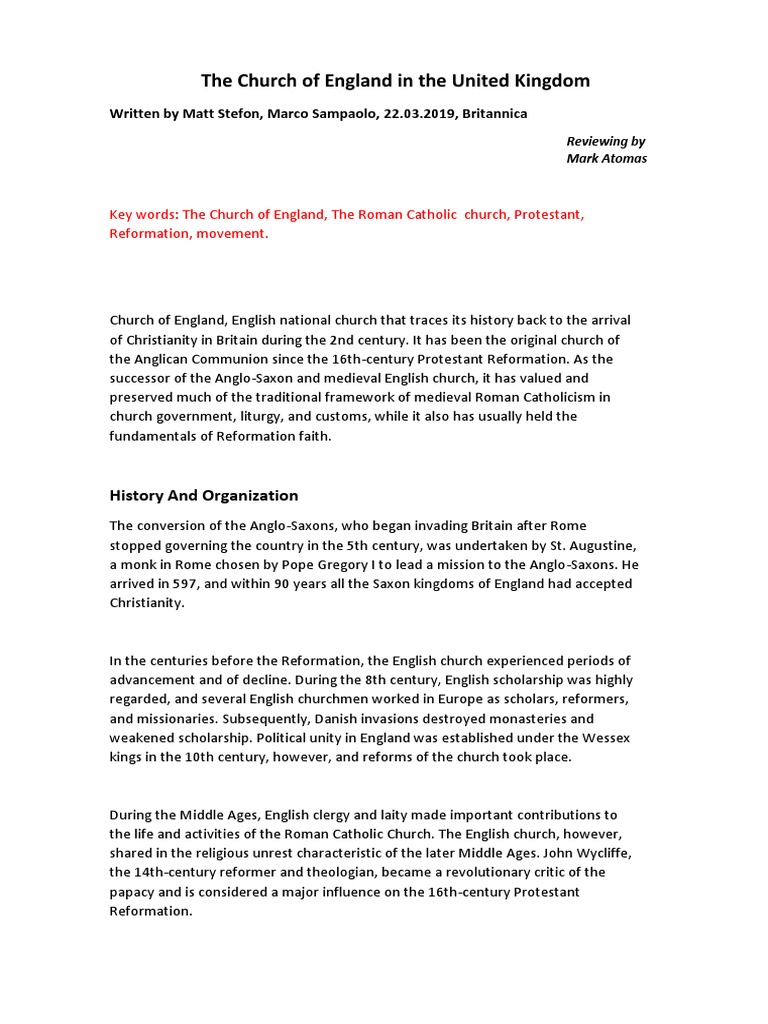In the annals of Christian history, the emergence of the Church of England offers a compelling narrative infused with theological, political, and cultural complexities. One might pose a playful question at the outset: “Was the formation of the Church of England a necessary evolution of faith or merely a consequence of royal ambition?” Such a query invites a more profound exploration of the entangled threads of dissent, desire for autonomy, and the overarching influence of the monarchy that characterized the English Reformation.
The genesis of the Church of England is most notably situated within the early 16th century, a time brimming with reformative zeal across Europe. The backdrop is defined by the burgeoning Protestant Reformation, spearheaded by figures such as Martin Luther, whose Ninety-Five Theses in 1517 ignited a conflagration of dissent against the Roman Catholic Church. This fervent desire for reform resonated throughout Christendom, echoing deeply within the English milieu.
Yet, England’s path toward establishing a distinct ecclesiastical identity was not solely about theological dissent. It was also profoundly influenced by the machinations of the monarchy, particularly under King Henry VIII. In the 1520s, Henry found himself embroiled in a personal crisis: his marriage to Catherine of Aragon had failed to produce a male heir. Desperate for a legitimate successor to secure the Tudor lineage, Henry sought an annulment of his marriage. However, Pope Clement VII, under political pressure from Catherine’s nephew, Charles V of the Holy Roman Empire, refused to grant this request.
This refusal set off a chain reaction. Henry’s frustrations eventually propelled him toward the realization that severing ties with Rome might serve both his personal ambitions and the broader concerns of English sovereignty. Thus began a series of legislative maneuvers that culminated in the Act of Supremacy in 1534, which declared Henry as the Supreme Head of the Church of England. With this, traditional Roman authority was repudiated, giving birth to a national church that retained certain Catholic sacramental practices, albeit with a distinctly English flavor.
Yet, the establishment of the Church of England was not simply a monarchical decree; it represented a profound shift in the locus of spiritual authority. The King’s assertion of supremacy was emblematic of a burgeoning national identity, reflecting a growing sentiment that the English crown should govern not only earthly realms but also spiritual matters. The question thus arises: was this move a divine revelation or an expedient consolidation of power?
The ramifications of Henry’s actions were manifold. The English Reformation initiated waves of theological discourse, and subsequent monarchs continued to navigate the complex landscape of religious ideology. Under Henry’s son, Edward VI, the Church of England saw a more pronounced adoption of Protestant doctrines, epitomized by the introduction of the Book of Common Prayer. This liturgical text emerged as a cornerstone of English worship, facilitating a clearer expression of Protestant theology and moving away from the remnants of Catholic practices.
However, the pendulum of religious fervor would swing with Mary I’s ascension to the throne. A devout Catholic, Mary sought to reverse the Reformation’s progress and reclaim England’s allegiance to the Papacy. Her reign was marked by significant persecution of Protestant reformers, which, paradoxically, solidified the resolve of those who supported the Church of England’s independence from Rome.
The religious landscape further evolved under Elizabeth I, who adeptly navigated the treacherous waters of sectarian conflict. The Elizabethan Religious Settlement sought a middle ground, embracing a via media that incorporated both Catholic and Protestant elements. This pragmatic approach not only reinforced Elizabeth’s authority but also aimed to unify a fragmented nation, demonstrating the intricate interplay between faith and governance in the shaping of English identity.
In contemplating the Church of England’s early developments, it is crucial to acknowledge the plethora of challenges it faced. The assertion of royal authority in religious matters was laden with tension, as various factions—including Puritans and Catholics—vied for influence and dominion. Furthermore, the theological debates that emerged during this tumultuous period often transcended mere ecclesiastical disputes, delving into questions of personal faith, communal identity, and the nature of divine authority. Believers grappled with the implications of a church led by the monarchy, pondering whether such a structure could genuinely reflect God’s will.
This historical trajectory prompts further inquiry into the church’s contemporary role within society. Can the Church of England maintain its relevance amid a rapidly diversifying religious landscape? How does its unique genesis inform modern theological and ecclesiastical challenges? The Church of England’s origins are both a testament to the complexities of human ambition and the divine narrative intertwined within Christian history. It serves as a reminder that faith, at times, aligns with earthly power, leading to transformations that resonate through subsequent generations.
In conclusion, the Church of England’s inception during the Reformation period illustrates an extraordinary confluence of royal authority, personal desire, and theological evolution. As we reflect on this critical juncture in Christian history, we recognize the dualities that exist—faith as a guide and a tool of power, reform as an aspiration and a reaction. The narrative persists, challenging modern believers to reflect on the interplay of faith and authority in their own spiritual journeys.



